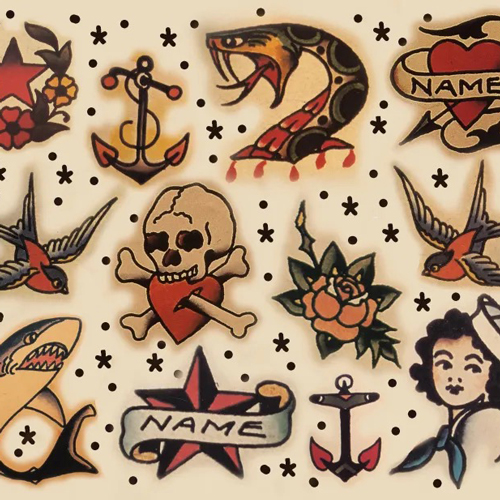

When people think of tattooing in the West, one image often comes to mind: bold black outlines, a limited palette of reds, greens, yellows, and blues, and timeless motifs like eagles, ships, roses, and daggers. This is American Traditional tattooing—a style as enduring as the sailors and rebels who first wore it. More than just an aesthetic, it is the visual language of a culture that prized boldness, patriotism, freedom, and defiance.
Roots in Sailor Culture
Tattooing in the United States has its roots in the late 19th and early 20th centuries, when sailors carried the art back from overseas voyages. They had seen Polynesian tatau, Japanese irezumi, and other indigenous traditions, and brought those influences home. Early American tattooers adopted and adapted these motifs, translating them into a new style that was quick, durable, and legible from a distance—perfect for life at sea.
For sailors, tattoos served as more than decoration. They were talismans and records of a life on the ocean.
Swallows marked miles traveled.
Anchors symbolized stability and safe return.
Ships celebrated adventure and freedom.
Nautical stars guided sailors home.
Each design carried meaning, turning the skin into a personal logbook of identity and experience.
The Birth of a Distinct Style
By the early 20th century, American tattooists were defining a distinct aesthetic: heavy black outlines, minimal shading, and a limited but bright color palette that would withstand sun, saltwater, and time. This style came to be known as American Traditional or “Old School.”
The legendary Norman “Sailor Jerry” Collins, working in Honolulu during the 1930s–1970s, became the central figure of this movement. He refined the style’s bold look, introduced new pigments, and created iconic flash sheets that still hang in tattoo shops today. His imagery blended Americana—eagles, flags, pin-up girls—with Asian influences, especially Japanese dragons and tigers.
Sailor Jerry’s tattoos weren’t just art—they were a cultural statement. They embodied the values of bravery, rebellion, and raw patriotism, worn proudly by servicemen during World War II, when tattooing exploded in popularity.
Symbols of Rebellion and Identity
By the mid-20th century, tattoos had spread beyond sailors to bikers, outlaws, and working-class communities. American Traditional tattoos became emblems of defiance and authenticity—marks of those living on the margins of polite society.
The motifs told stories anyone could read:
Daggers and snakes for danger and resilience.
Skulls for mortality and toughness.
Hearts with banners for loyalty and love.
Pin-ups for desire and remembrance of home.
These images were raw, direct, and universal—striking designs that carried weight in just a glance.
Survival and Revival
By the late 20th century, tattooing faced stigma in mainstream America. Yet the American Traditional style never disappeared. Its simplicity, boldness, and durability kept it alive through decades when tattoos were seen as fringe or taboo.
In recent years, there has been a powerful revival of American Traditional tattoos, driven by both heritage and aesthetics. Younger generations embrace the style not only for its nostalgic look, but for its authentic roots in history, working-class grit, and timeless symbolism. The designs that once covered sailors and soldiers now live on in tattoo shops worldwide, carried by people who see themselves in the tradition of boldness and rebellion.
A Timeless Language of the Skin
American Traditional tattoos endure because they are honest. They don’t hide in delicate detail or fleeting trends—they shout in bold lines and bright colors. They are legible, unapologetic, and built to last, just like the people who first wore them.
To wear an American Traditional tattoo is to carry a piece of history: a lineage of sailors, soldiers, rebels, and outcasts who carved their lives into the skin with courage and pride. It is more than art—it is a statement of belonging to a culture that values freedom, resilience, and identity written in ink.